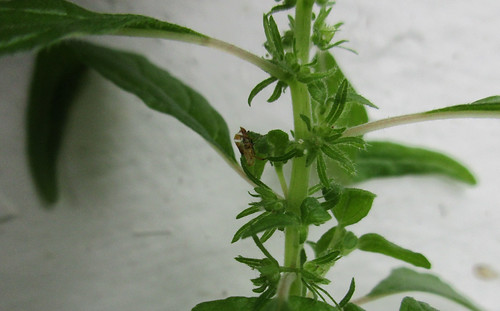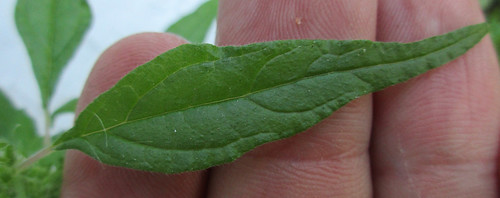Abundance: rare
What: leaves
How: raw, steamed
Where: shade, moist areas, yards
When: spring
Nutritional Value: potassium
Dangers: a small percentage of people are allergic to this plant and break out in hives if they eat it
Medicinal Summary:
Leaves/Stem - diuretic, in particular to help flush out kidney stones (tisane)

A lone, multi-stem Cucumber Weed hanging out next to a very old barn.

Close-up of single stem. Note flowers are directly attached to stem and leaves "zig-zag" up it.

Close-up of stem showing how flowers appear at the base of leaves.

Close-up of Cucumber Weed flowers. Like the leaves, they are green and hairy.

Close-up of mature leaf. It's edges are smooth, without any bumps/teeth.

Even closer close-up of leaf. Note the hairs, especially along the leaf's edge.

TOXIC MIMIC - Don't mistake members of the Acalypha genus for Cucumber Weed. They look similar in size, shape, and habitat but their actually easy to tell apart.

Acalypha leaves (picture below) lack hairs and have toothed edges unlike the smooth, hairy edge of Cucumber Weeds.

Texas distribution, attributed to U.S. Department of Agriculture. The marked counties are guidelines only. Plants may appear in other counties, especially if used in landscaping.

North American distribution, attributed to U.S. Department of Agriculture.

While not listed by the USDA as found in Harris and Montgomery counties of Texas, I find it in those locations quite often.
"Cool as a cucumber" is a good way to remember when to hunt Cucumber Weed. These small, delicious weeds appear in the cooler days of late fall through early spring, usually in moist, shady areas that see a lot of human traffic and the resulting soil damage. The particularly seem to like growing along cement foundations of buildings which suggests to me they prefer somewhat alkaline soils. They'll often be intermingled with other edible and non-edible weeds.
Cucumber Weed leaves zig-zag up the stem, alternating from side to side but since the square stem twists as it grows the leaves end up in a spiral. Along the upper portion of the stem two hairy, green flowers grow at the base of each leaf. These flowers are attached directly to the stem on either side of the leaf.
Use this cucumber-flavored plant raw in salads or smoothies. Supposedly it's good steamed then mixed with pasta in a white sauce, having a much milder flavor than spinach.
A number of members of the Acalypha resemble Cucumber Weed. Remember, if the leaf has teeth/bumps along its edge and isn't hairy you have a toxic Acalypha and NOT an edible Cucumber Weed.
Buy my book! Outdoor Adventure Guides Foraging covers 70 of North America's tastiest and easy to find wild edibles shown with the same big pictures as here on the Foraging Texas website.

